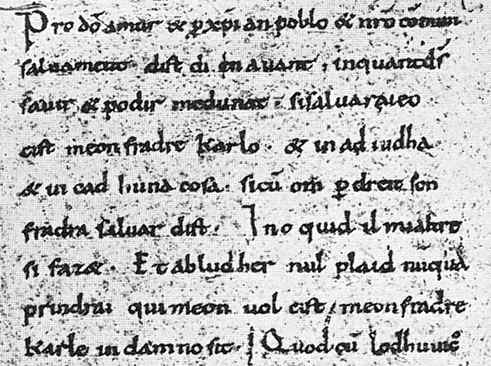Script Type : minuscule
Date : 10th century
Location : France, Germany, England, Spain, northern Italy, Scandinavia; this example from France
Function : Book hand and basis for document hands

























Distinctive letters : This is a segment from a 10th century copy of an earlier Latin chronicle, but the section shown is not Latin, but the earliest known written example of the lingua romana, or early French. It is followed in the chronicle by the same text in the lingua teudisca, or early German.
The Caroline minuscule script of this text has letter forms that are basically familiar to us. Among the finer points, a is a simple single celled letter with no curling projection at the top. The letter s always has the long form. The letter g has the form of two closed loops, in other words with a closed curling descender, while the descender of q is quite straight. The letter t is short with a wide crossbar. The letter z is short with no descender.
Ascenders on letters such as b, d, h and l tend to have wedged, and sometimes notched, tops.
The letters u and v and not differentiated, while w, which only appears in the Germanic text, is literally written as double u.
The letter k only appears as a capital in the name Karlo.
There are no examples of j or y.
The only ligature to be found is the letter combination et  in the form that would later, by some strange survival, evolve into the ampersand &.
in the form that would later, by some strange survival, evolve into the ampersand &.
Pass the cursor slowly down the lines of text to see a transcript, and see if it looks like Latin or French to you. For more information about the nefarious doings of the descendants of Charlemagne, and a more detailed look at both the French and German text, proceed to the paleography exercise.
Paleography
Exercises using Flash ![]()
Requires at least the Flash 5 plugin
If you are looking at this page without frames, there is more information about medieval writing to be found by going to the home page (framed) or the site map (no frames).